When it comes to installing LED lighting, one of the most crucial components often overlooked is the led driver power supply. While LEDs are known for their energy efficiency and long lifespan, the power supply you choose plays a significant role in ensuring that your lights perform optimally. Whether you’re a homeowner, business owner, or lighting professional, choosing the right LED driver power supply is essential for ensuring longevity, reliability, and energy efficiency.
In this blog, we will walk you through everything you need to know about LED driver power supplies, including their functions, types, and the factors to consider when making the right choice.
What Is an LED Driver Power Supply?
An LED driver power supply is a device that regulates the power supplied to LED lights. LEDs typically require a low-voltage DC (direct current) to function correctly. The driver ensures that the proper voltage and current are delivered to the LED, adjusting to fluctuations in the power grid or other external factors.

Unlike incandescent lights, which are powered by high-voltage AC (alternating current), LEDs require a constant, stable power supply to operate efficiently. Without a proper driver, your LEDs could experience problems such as flickering, reduced lifespan, or poor color rendering.
Key Functions of an LED Driver Power Supply
Understanding the role of an LED driver power supply can help you make an informed decision. Here are the key functions of an LED driver:
1. Voltage Regulation
LEDs require a specific operating voltage to ensure optimal performance. The driver regulates the voltage to ensure the LED receives a constant power supply.
2. Current Control
LEDs operate efficiently at a specific current. An LED driver regulates the current flow to prevent overloading and ensure consistent brightness.
3. Efficiency and Conversion
An LED driver converts the incoming high-voltage AC power from the electrical grid into a usable low-voltage DC power for the LEDs. Efficient conversion reduces energy consumption, contributing to the energy-saving benefits of LEDs.
4. Protection
LED drivers often come with built-in protection mechanisms like over-voltage, over-current, and short-circuit protection. These protections safeguard both the LEDs and the driver itself from damage.
Types of LED Drivers
When choosing an LED driver power supply, it’s important to understand the different types available. The two main types of LED drivers are:

1. Constant Current LED Drivers
Constant current drivers are designed to supply a fixed current to the LED. Since LEDs have a fixed forward voltage, a constant current driver ensures that the LED receives the exact current it requires, which is essential for achieving consistent brightness and performance.
- Best for: LED applications that require high brightness and constant illumination, such as street lights or high-performance LED panels.
- Advantages: Higher efficiency, more precise control over the LEDs’ performance.
2. Constant Voltage LED Drivers
Constant voltage drivers are used when the LED operates at a constant voltage, rather than a constant current. These drivers are best suited for LED strips or bulbs that require a constant voltage input.
- Best for: LED strips, signage, and decorative lighting.
- Advantages: Simpler design, often more cost-effective for non-complex lighting setups.
Factors to Consider When Choosing the Best LED Driver Power Supply
Choosing the right LED driver power supply depends on several factors that directly impact the performance of your LEDs. Below are the key factors to consider:
1. Wattage and Power Requirements
The first step in choosing the right LED driver is determining the wattage or power requirements of the LED system you are using. Make sure the driver you select can handle the wattage of your LED lights.
- How to calculate: Add up the wattage of all the LEDs in your setup and choose a driver with at least a 20% buffer above that total to ensure it’s not overburdened.
For example, if your setup requires 100 watts of power, choose a driver rated for at least 120 watts.
2. Voltage Compatibility
LEDs come in various voltage requirements, so it’s important to choose a driver that matches the voltage requirement of your LED lights. This is especially important when using LED strips or bulbs, which often have specific voltage needs.
- For constant current drivers: Make sure the output current matches the requirements of your LEDs.
- For constant voltage drivers: Ensure the driver’s output voltage matches the operating voltage of your LEDs.
3. Dimmability
If you plan on using dimmable LEDs, you need to ensure that the driver supports dimming functionality. Dimmable LED drivers offer smooth dimming, providing flexibility for creating different moods or saving energy.
- Tip: Not all LED drivers are compatible with all dimming systems (such as triac or 0-10V). Always verify compatibility with your dimmer switches before purchase.
4. Efficiency
The efficiency of the LED driver is a critical factor in reducing energy consumption and ensuring that your lights perform at their best. A high-efficiency LED driver minimizes wasted energy, meaning more power is used to illuminate the LEDs rather than being lost as heat.
- Tip: Look for drivers with an efficiency rating of 85% or higher for optimal performance.
5. Size and Form Factor
LED drivers come in various sizes and designs. Ensure that the size of the driver fits your installation space, especially if you are working with compact setups like recessed lights or slim-profile LED strips.
- Tip: Consider enclosed drivers for outdoor or industrial applications where environmental protection is needed.
6. Environmental Considerations
If you are installing LED lights in an outdoor or industrial environment, ensure that the driver is rated for waterproof or dustproof applications. This will protect the driver from environmental factors and ensure long-term reliability.
- IP Rating: Choose a driver with a suitable IP (Ingress Protection) rating. For example, IP65 is ideal for outdoor use, offering protection against water jets and dust.
7. Certifications and Quality
To ensure safety and performance, always choose an LED driver that has relevant certifications. Some certifications to look for include:
- CE Certification: Indicates compliance with European health, safety, and environmental protection standards.
- UL Listing: Ensures the product meets safety standards in North America.
- RoHS Compliance: Indicates the driver is free from hazardous materials like lead and mercury.
Advantages of Choosing the Right LED Driver Power Supply

Choosing the correct LED driver has several benefits:
- Extended LED lifespan: A quality driver can help ensure that your LEDs operate within their ideal parameters, leading to longer-lasting lighting solutions.
- Energy efficiency: A properly matched driver ensures that your LED system uses the least amount of energy while still providing optimal brightness.
- Flicker-free performance: A good driver prevents flickering, ensuring smooth and stable lighting.
- Cost savings: A high-quality driver prevents damage to your LEDs, reducing the frequency of replacements and repairs.
Common Mistakes to Avoid When Choosing LED Drivers
To make sure you select the right LED driver, avoid these common mistakes:
- Choosing a driver with inadequate power output: Always ensure that the power supply can meet the wattage needs of your entire LED setup.
- Ignoring compatibility with the voltage requirements of your LEDs: Double-check the voltage compatibility of the driver with your LED type.
- Not considering environmental factors: If your LEDs will be exposed to outdoor conditions, choose a waterproof and dustproof driver to enhance durability.
- Skipping out on certifications: Ensure the driver has necessary safety certifications like UL and CE.
Conclusion: Finding the Perfect LED Driver Power Supply
Choosing the best LED driver power supply is essential for achieving quality lighting that is energy-efficient, long-lasting, and safe. By considering factors like wattage, voltage compatibility, efficiency, and environmental conditions, you can ensure that your LED lighting system performs optimally. Always prioritize the quality of your LED driver to get the most out of your lighting setup, whether it’s for home, office, or industrial use.
With the right LED driver, you’ll enjoy smooth, reliable, and bright lighting that enhances both functionality and aesthetics. Happy lighting!
FAQs
Q1: How do I know which LED driver to choose?
Ensure the driver matches the power, voltage, and current requirements of your LED lights. For dimmable LEDs, check if the driver supports dimming.
Q2: Can I use any power supply for my LED lights?
No, LEDs require specific drivers designed for their voltage and current needs. Using an incompatible driver can damage your LEDs or result in poor performance.
Q3: What is the best type of LED driver for home lighting?
For most home lighting, a constant voltage driver is recommended, especially for LED strips and bulbs.
Read More: Top 10 Review Games to Play in 2025





